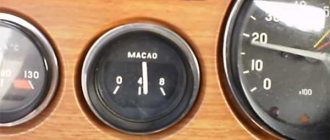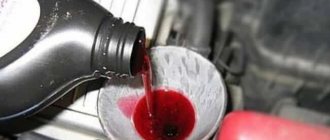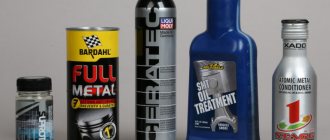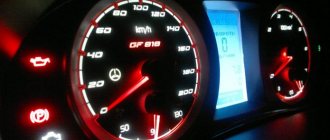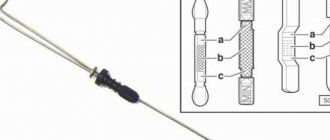How is engine oil consumption calculated?
To determine the norm, it is not the mileage value that is taken into account, but the fuel consumption. This indicator is more accurate than the distance traveled, because when you are stuck in traffic jams, the oil is depleted even more, and the odometer does not change its value.
Engine oil consumption is usually calculated based on the volume spent on burning 100 liters of fuel.
To find out the oil consumption rate in your car's engine, you need to use a calculation formula and a calculator, or use this online form. It involves calculating the permissible amount of oil for waste according to the type of engine, the volume of operating oil and the amount of fuel consumed, taking into account the condition of the piston group.
Calculation formulas for oil consumption
The total actual oil consumption for waste during its operating cycle (from replacement to replacement) can be calculated using the formula:
Where ∑q is the oil added during the cycle (between maintenance); Qз - filled during refueling; Qsl – drained during replacement.
But the consumption of poured oil in liters per 100 liters of fuel is determined as follows:
Where V is the capacity of the engine lubrication system; P – consumed fuel k – coefficient taking into account wear of the piston group (k – for a diesel car 1.25; petrol 1.15; turbo 1.3).
Engine oil consumption rate for waste
For passenger vehicles, the normal burn rate is 0.005 - 0.025% per 100 liters of fuel, which is approximately 5 to 25 grams of oil per 1 thousand km. In a worn engine it can reach up to 0.1% and 100 g. per 1000 km respectively. Well, if the car operates at the limit or has a turbocharged or diesel unit, then this norm will be even higher.
For long cargo trucks, the oil consumption rate is 0.3 - 0.4% of fuel consumption. The calculation formula uses the amount of fuel burned and oil added during this period. But this calculation of oil consumption, proposed by the automaker Scania, is relevant only for heavy cars with a large engine. Calculations of lubricant consumption in passenger cars, both with diesel and gasoline engines, have a slightly different form.
Engine oil consumption rate per 100 liters. fuel for passenger cars
| engine's type | Acceptable waste | |||
| In percent, % 100 l. fuel | In grams, g per 1000 km | |||
| New | Worn out | New | Worn out | |
| Petrol | 0,005 – 0,025 | 0,025 – 0,1 | 5 to 25 | 25 – 100 |
| Turbocharged | 0,05 – 0,08 | 0,5 – 1 | up to 100 | 100 – 300 |
| Diesel | 0,035 – 0,25 | 0,3 – 0,8 | 30 – 55 | up to 200 |
| Rotary | 0,5 – 1,2 | 1 – 2 | 500 – 1000 | up to 2000 |
A gasoline engine operating at the limit of its capabilities can consume from 0.4 to 0.6% at 100 hp. fuel consumed, which is approximately 400 - 600 grams of engine oil per 1000 km. The situation is exactly the same with diesel engines - engine lubricant consumption increases by 0.5%. But if these are forced turbodiesels with two turbines, then the consumption can reach up to 3% of the volume of oil poured into the engine.
Keep in mind that oil consumption rates increase significantly for cars after major repairs and in operation for more than five years .
Method for determining oil consumption
Oil level on dipstick
Determination of the actual value of specific engine oil consumption for waste is carried out over a mileage of 200-300 km. The vehicle must be technically sound during the test drive. The oil level in the crankcase should be between the “MAX” and “MIN” marks on the engine dipstick. Before the test run, it is necessary to warm up the engine, the oil temperature should be 80-85°C. Drain the oil on a level surface. It should drain from the pan within 15 minutes. For the accuracy of the result, it is advisable to determine not the volume, but rather the weight, since the amount of lubricant remaining in the filter can only be determined by weighing it.
What oil consumption per 100 liters of fuel is considered normal?
To determine the rate of engine oil consumption, you can use the amount of fuel used for calculations. This method is more accurate than calculations based on distance traveled, since when standing in a traffic jam, the oil consumption of the engine increases, while the odometer value remains unchanged.
Oil consumption standards increase significantly for machines that have undergone major overhauls and have been in operation for more than 5 years. The average level of engine oil consumed by the engine after 150,000 km is in the range from 0.35 to 0.55 l .
FAQ
What is the norm for gasoline and diesel units?
A gasoline engine that operates at the limit of its capabilities consumes 0.4-0.6 percent per 100 liters of fuel burned, which is approximately 400 to 600 g of engine oil per 1,000 km run. With a diesel engine, the situation is similar - during intensive use, the engine begins to consume lubricants by 0.5 percent more. For a forced turbodiesel with 2 turbines, the consumption reaches 3 percent of the volume of engine oil that is poured into the engine.
How to use the calculator
One of the main roles in this calculation is played by the volume of fuel burned and the volume of operating oil, as well as the type of engine. It is in relation to this volume and specifics of work that the specific oil consumption is calculated.
To calculate specific engine oil consumption, the following data is required:
Such a calculation calculator can be an indispensable assistant for calculating the consumption rate of lubricants intended for operational accounting of the specific consumption of motor oil when justifying the need for them. After all, if not all, then many car enthusiasts have a rather wary attitude towards engine oil consumption. This service will show whether you are within the nominal values. If not, then you will have an objective reason to look for reasons and possible problems.
What's the outcome
That is, if the engine is in order, then it takes practically no oil, and you will not need to top it up until the next change. Its level will be within acceptable limits on the dipstick (within the min./max. marks). But there are cases when the manufacturer indicates consumption rates for a specific power unit (some engines eat oil), then topping it up is considered natural and is not a malfunction, but on average it does not exceed 1-2 glasses from replacement to replacement.
It is important to understand that the harder the engine runs, the more oil it burns. For example, the higher the number of revolutions, the more oil will remain in the cylinders of the car engine. Although we should not forget not only about the operating mode of the engine, but also its design. You should also not neglect the tolerances of motor oils and fill in fuels and lubricants of dubious quality.
High oil consumption: reasons
There are a number of reasons that can increase fluid intake, the main ones are given below.
Note! If you cannot independently determine the cause of the intense loss, it is recommended to seek qualified help from a service station mechanic.
Engine wear
Critical consumption of working fluid is usually caused by a decrease in compression of the working cylinders. This is usually associated with sinking or coking of the piston rings, and wear-out of the cylinder-piston group. In some cases, poor quality overhaul of the power plant occurs. Negligent craftsmen may mistakenly select design elements, which subsequently causes “gorging” of the lubricant.
The second factor is the breakdown of the unit. A breakdown of the crankcase gasket, cylinder head or one of the shaft seals is the primary cause of loss of lubricant capacity.
Errors in selection
Another reason for increased engine oil consumption is driver oversight. Each motor is designed for a specific lubricant. Non-compliance with the manufacturer's tolerances causes burnout of the formula and increased entry into the combustion chambers (too thin oil). Additionally, the inadequacy of the liquid base may have an effect. For example, for outdated units it is not recommended to fill in synthetics - the base is excessively fluid. Therefore, the percentage of lubricant leaked into the pistons increases.
Important! The technical documentation of the vehicle contains a complete list of approvals and compliances applicable to motor fluids.
Poor quality oil
The most common problem when an engine consumes oil is the operation of a fake. The surrogate lubricant provokes unexpected chemical processes inside the crankcase compartment. The reactions are not limited to oxidation or instability of viscosity - the “pirate” formula in 70% of cases does not meet the standards for high-temperature destruction. Actually, this is the reason for burnout and increased oil consumption.
FAQ
Formula for calculating oil consumption
Calculation of oil consumption can be carried out on waste, for the cycle of its operation between maintenance and consumption per 100 liters of burned fuel. The formulas for these two calculation options will be different. Engine oil waste from replacement to replacement is calculated by the formula: Qy = ∑q + (Qз-Qсл), where ∑q is the amount of oil added, Qз is the oil that was poured into the engine during replacement, Qсл is the amount of oil that was drained.
To calculate the consumption of the filled oil, which needed to be added only during the period of 100 liters of fuel burned by the car, the calculation formula is: Mз = V / (P*k), where V is the capacity of the entire engine lubrication system, P is the fuel consumed, k is the coefficient piston wear (varies depending on the engine, if diesel, then used - 1.25; gasoline - 1.15; turbo - 1.3).
Consumption rates for lubricants and operating materials
The consumption standards for lubricants in motor vehicles are intended for operational accounting and calculation of specific consumption rates for oils and lubricants when justifying the need for them for enterprises operating motor vehicles.
The operating consumption standards for lubricants (taking into account replacement and current refills) are set per 100 liters of total fuel consumption, calculated according to the standards for a given vehicle. Oil consumption rates are set in liters per 100 liters of fuel consumption, lubricant consumption rates are set in kilograms per 100 liters of fuel consumption.
Oil consumption rates increase to 20 percent for cars after major repairs and in operation for more than five years.
The consumption of lubricants during major repairs of automobile units is set in an amount equal to one filling capacity of the lubrication system of this unit.
The consumption of brake, coolant and other working fluids is determined in the quantity and volume of refills and refills per vehicle in accordance with the recommendations of manufacturers, operating instructions, etc.
Table 8 - Individual operational standards for oil consumption in liters (lubricants in kg) per 100 liters. total vehicle fuel consumption, no more
For vehicles and their modifications for which there are no individual standards for the consumption of oils and lubricants, the following temporary standards for the consumption of oils and lubricants have been established:
Table 9 - Temporary reference standards for oil and lubricant consumption
| Types and grades of oils (lubricants) | Temporary rate of oil consumption in liters (lubricants in kg) per 100 liters of total rated fuel consumption, no more, for: | ||
| Trucks running on gasoline, compressed and liquefied gas | Trucks running on diesel fuel | Off-road dump trucks running on diesel fuel | |
| Motor oils | 2,4 | 3,2 | 4,5 |
| Transmission and hydraulic oils | 0,3 | 0,4 | 0,5 |
| Special oils and liquids | 0,1 | 0,1 | 1,0 |
| Plastic (grease) lubricants | 0,2 | 0,3 | 0,2 |
Depreciation rates
Table 10 – Depreciation of rolling stock of road transport
| Groups and types of road transport | Depreciation rates | |
| as a percentage of the cost of the car | as a percentage of the cost of the car per 1000 km | |
| Cars with carrying capacity: up to 0.5 t | 20,0 | — |
| from 0.5 to 2 t | 14,3 | — |
| More than 2 tons with a resource before major repairs: up to 200 thousand km | — | 0,37 |
| from 200 to 250 thousand km | — | 0,30 |
| from 250 to 350 thousand km | — | 0,20 |
| from 350 to 400 thousand km | — | 0,17 |
| Trailers and semi-trailers with carrying capacity: up to 8t | 12,5 | — |
| more than 8t | 10,0 | — |
| dump trailers | 14,3 | — |
Cost standards for spare parts and materials
Table 11 – Cost standards for spare parts and materials
(rub.kop. per 1000 km)
Labor intensity standards and correction factors
Table 12 – Load capacity utilization factor by cargo class
| Load capacity utilization factor | Average capacity utilization factor | Cargo class |
| 0.91 or more | 1,00 | |
| 0,90-0,71 | 0,80 | |
| 0,70-0,51 | 0,60 | |
| 0,50-0,40 | 0,45 |
Table 13 - Maintenance intervals
| TO-1 | TO-2 |
| Trucks |
Table 14 – Labor intensity standards for maintenance and current repairs of rolling stock
Table 15 – Classification of operating conditions
| Category of operating conditions | Driving conditions | ||
| Outside the suburban area (more than 50 km from the city border | In small towns (up to 100 thousand inhabitants) and in the suburban area | In large cities (more than 100 thousand inhabitants) | |
| I | D1 – P1, P2, P3 | – | – |
| II | D1 – P4 D2 – P1, P2, P3, P4 D3 – P1, P2, P3 | D1 – P1, P2, P3, P4 D2 – P1 | – |
| III | D1 – P5 D2 – P5 D3 – P4, P5 D4 – P1, P2, P3, P4, P5 | D1 – P5 D2 – P2, P3, P4, P5 D3 – P1, P2, P2, P3, P4, P5 D4 – P1, P2, P2, P3, P4, P5 | D1 – P1, P2, P3, P4, P5 D2 – P1, P2, P3, P4 D3 – P1, P2, P3 D4 – P1 |
| IV | D5 – P1, P2, P2, P3, P4, P5 | D5 – P1, P2, P2, P3, P4, P5 | D2 – P5 D3 – P4, P5 D4 – P2, P3, P4, P5 D5 – P1, P2, P3, P4, P5 |
| V | D6 – P1, P2, P2, P3, P4, P5 |
D1 – cement concrete, asphalt concrete, paving stones, mosaic;
D2 – bitumen-mineral mixtures
D3 – crushed stone (gravel) without treatment, tar concrete;
D4 – cobblestone, crushed stone, soil and low-strength stone, treated with binding materials, winter roads;
D5 – soil strengthened or improved with local materials; wooden and log coverings;
D6 – natural dirt roads; temporary intra-quarry and dump roads; access roads that do not have a hard surface.
Type of terrain (determined by altitude above sea level):
P1 – flat (up to 200 m);
P2 – slightly hilly (over 200 to 300 m);
P3 – hilly (over 300 to 1000 m);
Р4 – mountainous (over 1000 to 2000 m);
P5 – mountain (over 2000m).
Table 16 – Standards adjustment coefficient depending on operating conditions – K1
| Category of operating conditions | Standards | |||
| Maintenance intervals | Specific labor intensity of current repairs | Mileage before major overhaul | Spare parts consumption | |
| I | 1,0 | 1,0 | 1,0 | 1,00 |
| II | 0,9 | 1,1 | 0,9 | 1,10 |
| III | 0,8 | 1,2 | 0,8 | 1,25 |
| IV | 0,7 | 1,4 | 0,7 | 1,40 |
| V | 0,6 | 1,5 | 0,6 | 1,65 |
Table 17 – Standards adjustment coefficient depending on the modification of rolling stock and the organization of its work – K2
| Modification of rolling stock and organization of its work | Standards | ||
| Labor intensity of maintenance and repair | Mileage before major overhaul | Spare parts consumption | |
| Base car | 1,00 | 1,00 | 1,00 |
| Truck tractors | 1,10 | 0,95 | 1,05 |
| Vehicles with one trailer | 1,15 | 0,90 | 1,10 |
| Cars with two trailers | 1,20 | 0,85 | 1,20 |
| Dump trucks when working on shoulders over 5 km | 1,15 | 0,85 | 1,20 |
| Dump trucks with one trailer when working on short legs (up to 5 km) | 1,20 | 0,80 | 1,25 |
| Dump trucks with two trailers | 1,25 | 0,75 | 1,30 |
Legislative framework of the Russian Federation
canceled/voided Edition dated 29.04.1997
detailed information
| Name of document | “NORMAL CONSUMPTION OF FUELS AND LUBRICANTS IN ROAD TRANSPORT (R 3112194-0366-97)” (approved by the Ministry of Transport of the Russian Federation on April 29, 1997) |
| Document type | order |
| Receiving authority | Ministry of Transport of the Russian Federation |
| Document Number | R 3112194-0366-97 |
| Acceptance date | 01.01.1970 |
| Revision date | 29.04.1997 |
| Date of registration with the Ministry of Justice | 01.01.1970 |
| Status | cancelled/lost force |
| Publication |
|
| Navigator | Notes |
“NORMAL CONSUMPTION OF FUELS AND LUBRICANTS IN ROAD TRANSPORT (R 3112194-0366-97)” (approved by the Ministry of Transport of the Russian Federation on April 29, 1997)
4. CONSUMPTION RATES FOR LUBRICANTS AND SPECIAL FLUIDS
The consumption standards for lubricants in motor transport are intended for operational accounting and calculation of specific consumption rates for oils and lubricants when justifying the need for them in motor transport enterprises.
Lubricant consumption rates are set per 100 liters of total fuel consumption, calculated according to the standards for a given vehicle. Oil consumption rates are set in liters per 100 liters of fuel consumption, lubricant consumption rates are set in kilograms per 100 liters of fuel consumption, respectively. In the Ministry of Defense of the Russian Federation, consumption standards for lubricants are set in kg for the type of maintenance and repair, and for motor oils - as a percentage of fuel consumption.
Oil and lubricant consumption rates are reduced by 50 percent for all vehicles in operation for up to three years (except for VAZ vehicles and foreign passenger cars).
Oil consumption rates increase to 20 percent for vehicles that have been in operation for more than eight years.
The consumption of lubricants during major repairs of automobile units is set in an amount equal to one filling capacity of the lubrication system of this unit.
The consumption of brake and coolant fluids is determined in the number of refills per vehicle.
Individual standards for oil consumption in liters (lubricants in kg) per 100 liters of total vehicle fuel consumption
| Car make, model | Motor oils | Transmission oils | Special oils | Greases |
| 1 | 2 | 3 | 4 | 5 |
| Cars | ||||
| VAZ cars of all models and modifications | 0,6 | 0,1 | 0,03 | 0,1 |
| GAZ-13, -14 | 1,8 | 0,15 | 0,05 | 0,1 |
| GAZ-M20, -21, -22 | 2,0 | 0,15 | 0,05 | 0,1 |
| GAZ-24 of all modifications | 1,8 | 0,15 | 0,05 | 0,1 |
| GAZ-24-07, -24-17 | 1,6 | 0,15 | 0,05 | 0,1 |
| GAZ-3102 of all modifications | 1,7 | 0,15 | 0,05 | 0,1 |
| ZAZ-965, -966, -968, -969, -970 of all modifications | 1,3 | 0,1 | 0,03 | 0,1 |
| ZAZ-1102 | 0,8 | 0,1 | 0,03 | 0,1 |
| ZIL-114, -117, -4104 | 1,7 | 0,15 | 0,05 | 0,1 |
| IZH-2125 of all modifications | 1,8 | 0,15 | 0,05 | 0,1 |
| Moskvich-403, -407, -408, -410, -411, -424, -426, -432 | 2,0 | 0,15 | 0,05 | 0,1 |
| Moskvich-412, -427, -433, -434, -2136, -2137, -2140, -2141 of all modifications | 1,8 | 0,15 | 0,05 | 0,1 |
| LuAZ-969, -1302 of all modifications | 1,3 | 0,1 | 0,03 | 0,1 |
| UAZ-469, -3151 of all modifications | 2,2 | 0,2 | 0,05 | 0,2 |
| Buses | ||||
| ZIL-155, -158 of all modifications | 2,2 | 0,25 | 0,1 | 0,2 |
| Ikarus-55 of all modifications | 2,9 | 0,4 | 0,1 | 0,3 |
| Ikarus-180, -250, -255, -256, -260, -263, -280 all modifications | 4,5 | 0,5 | 0,1 | 0,3 |
| KAvZ-651, -651A | 2,2 | 0,25 | 0,1 | 0,25 |
| KAvZ-685, -3270, -3976 all modifications | 2,1 | 0,3 | 0,1 | 0,25 |
| LAZ-695, -697 all modifications | 2,0 | 0,3 | 0,1 | 0,2 |
| LAZ-699 of all modifications | 2,0 | 0,35 | 0,1 | 0,2 |
| LAZ-4202 of all modifications | 2,8 | 0,4 | 0,15 | 0,35 |
| LiAZ-158 of all modifications | 2,2 | 0,25 | 0,1 | 0,2 |
| LiAZ-677 of all modifications | 1,8 | 0,35 | 0,3 | 0,2 |
| LiAZ-5256 of all modifications | 2,8 | 0,4 | 0,3 | 0,35 |
| Nusa-501, -521, -522 all modifications | 2,2 | 0,2 | 0,05 | 0,2 |
| PAZ-651, -652 of all modifications | 2,2 | 0,25 | 0,1 | 0,25 |
| PAZ-672, -3201, -3205, -3206 of all modifications | 2,1 | 0,3 | 0,1 | 0,25 |
| RAF-977 of all modifications | 2,0 | 0,15 | 0,05 | 0,1 |
| RAF-2203 of all modifications | 1,8 | 0,15 | 0,05 | 0,1 |
| UAZ-452, -2206, -3962 of all modifications | 2,2 | 0,2 | 0,05 | 0,2 |
| Avia-20, -21, -30, -31 of all modifications | 2,8 | 0,4 | 0,1 | 0,3 |
| GAZ-51 of all modifications | 2,2 | 0,25 | 0,1 | 0,25 |
| GAZ-52, -52-27, -52-28 all modifications | 2,2 | 0,3 | 0,1 | 0,25 |
| GAZ-52-07, -52-08, -52-09 | 2,0 | 0,25 | 0,07 | 0,2 |
| GAZ-53, -53-27 all modifications | 2,1 | 0,3 | 0,1 | 0,25 |
| GAZ-53-07, -53-19 | 1,8 | 0,25 | 0,07 | 0,2 |
| GAZ-66 of all modifications | 2,1 | 0,3 | 0,1 | 0,25 |
| GAZ-3307 | 2,1 | 0,3 | 0,1 | 0,25 |
| ZIL-130, -131, -133, -138A, -138AB, -138AG, -4314, 4315, -4316, -4319 all modifications | 2,2 | 0,3 | 0,1 | 0,2 |
| ZIL-133GYA | 2,8 | 0,4 | 0,15 | 0,35 |
| ZIL-138, -4318 | 1,7 | 0,25 | 0,07 | 0,15 |
| ZIL-150, -151, -157, -164 all modifications | 2,2 | 0,25 | 0,1 | 0,2 |
| ZIL-166A, -166V | 1,7 | 0,25 | 0,07 | 0,15 |
| ZIL-4331 of all modifications | 2,8 | 0,4 | 0,15 | 0,35 |
| IFA W50L of all modifications | 2,9 | 0,4 | 0,1 | 0,3 |
| KamAZ-4310, -5320, -5321 of all modifications | 2,8 | 0,4 | 0,15 | 0,35 |
| KrAZ-214, -219, -221, -222 of all modifications | 3,0 | 0,4 | 0,1 | 0,35 |
| KrAZ-255, -256, -257, -258, -260 of all modifications | 2,9 | 0,4 | 0,1 | 0,3 |
| MAZ-200 of all modifications | 3,0 | 0,4 | 0,1 | 0,35 |
| MAZ-500, -514, -516, -5334, -5335, -5337 all modifications | 2,9 | 0,4 | 0,15 | 0,35 |
| MAZ-543, -7310, -7313 of all modifications | 4,5 | 0,5 | 1,0 | 0,3 |
| Magirus 232D19L, 290D26L | 2,5 | 0,4 | 0,1 | 0,3 |
| Tatra 111R | 2,9 | 0,4 | 0,1 | 0,3 |
| Ural-355 of all modifications | 2,2 | 0,25 | 0,1 | 0,25 |
| Ural-375, -377 all modifications | 1,8 | 0,35 | 0,1 | 0,2 |
| Ural-4320 of all modifications | 2,8 | 0,4 | 0,15 | 0,35 |
| UAZ-450, -451, -452, -3303, -3741 of all modifications | 2,2 | 0,2 | 0,05 | 0,2 |
| YaAZ-210, -210A | 3,0 | 0,4 | 0,1 | 0,35 |
| Tractors | ||||
| Avstro-Fiat 5DN-120, 6DN-130 | 2,9 | 0,4 | 0,1 | 0,3 |
| BelAZ-537L, -6411, -7421 | 4,5 | 0,5 | 1,0 | 0,3 |
| Volvo-F10-33, -F89-32 | 2,5 | 0,4 | 0,1 | 0,3 |
| GAZ-51P | 2,2 | 0,25 | 0,1 | 0,25 |
| GAZ-52-06 | 2,2 | 0,3 | 0,1 | 0,25 |
| ZIL-120N | 2,2 | 0,25 | 0,1 | 0,2 |
| ZIL-130AN, -130V, -131V, -131NV, -4415, -4413 all modifications | 2,0 | 0,3 | 0,1 | 0,2 |
| ZIL-138V1, -4416 all modifications | 1,7 | 0,25 | 0,07 | 0,15 |
| ZIL-157V, -157KV, -157KDV, -164AN, -164N | 2,2 | 0,25 | 0,1 | 0,2 |
| Iveco-190.33, -190.42 | 2,5 | 0,4 | 0,1 | 0,3 |
| KAZ-120TZ, -606 all modifications | 2,2 | 0,25 | 0,1 | 0,2 |
| KAZ-608 of all modifications | 2,0 | 0,3 | 0,1 | 0,2 |
| KamAZ-5410, -54118 all modifications | 2,8 | 0,4 | 0,15 | 0,35 |
| KrAZ-221 of all modifications | 3,0 | 0,4 | 0,1 | 0,35 |
| KrAZ-255, -258, -260, -6437, -6443, -6444 of all modifications | 2,9 | 0,4 | 0,1 | 0,3 |
| KNVF-12T Kamacu-Nissan | 2,5 | 0,4 | 0,1 | 0,3 |
| KZKT-537, -7427, -7428 | 4,5 | 0,5 | 1,0 | 0,3 |
| LuAZ-2403 | 1,3 | 0,1 | 0,03 | 0,1 |
| MAZ-200 of all modifications | 3,0 | 0,4 | 0,1 | 0,35 |
| MAZ-504, -509 of all modifications | 2,9 | 0,4 | 0,15 | 0,35 |
| MAZ-537, -543 | 4,5 | 0,5 | 1,0 | 0,3 |
| MAZ-5429, -5430, -5432, -5433 of all modifications | 2,8 | 0,4 | 0,1 | 0,3 |
| MAZ-6422 of all modifications | 2,8 | 0,4 | 0,1 | 0,3 |
| MAZ-7310, -7313 of all modifications | 4,5 | 0,5 | 1,0 | 0,3 |
| MAZ-7916 | 4,5 | 0,5 | 1,0 | 0,3 |
| Mercedes-Benz-1635S, -1926, -1928, -1935, -2232S, -2235, -2236 all modifications | 2,5 | 0,4 | 0,1 | 0,3 |
| Mercedes-Benz-2628, -2632 | 2,5 | 0,4 | 0,1 | 0,3 |
| Praga ST2-TN | 2,9 | 0,4 | 0,1 | 0,3 |
| Tatra-815TP of all modifications | 2,8 | 0,4 | 0,1 | 0,3 |
| Ural-375S, -377S of all modifications | 1,8 | 0,35 | 0,1 | 0,2 |
| Ural-4420 of all modifications | 2,8 | 0,4 | 0,15 | 0,35 |
| Faun H-36-40/45, H-46-40/49 | 4,5 | 0,5 | 1,0 | 0,3 |
| Chepel D-450 of all modifications | 2,9 | 0,4 | 0,1 | 0,3 |
| Scoda-Lias-100 of all modifications | 2,5 | 0,4 | 0,1 | 0,3 |
| Scoda-706 of all modifications | 2,9 | 0,4 | 0,1 | 0,3 |
| Dump trucks | ||||
| Avia A-30KS | 2,8 | 0,4 | 0,1 | 0,3 |
| BelAZ-540, -540A, -7510, -7522, -7526 | 4,5 | 0,5 | 1,0 | 0,3 |
| BelAZ-548, -548A, -549, -7509, -7519, -7521, -7523, -7525, -7527, -75401, -7548 of all modifications | 4,3 | 0,5 | 1,0 | 0,3 |
| GAZ-53B | 2,1 | 0,3 | 0,1 | 0,25 |
| GAZ-93 of all modifications | 2,2 | 0,25 | 0,1 | 0,25 |
| GAZ-SAZ-2500, -3507, -3508, -3509, -3510 all modifications | 2,1 | 0,3 | 0,1 | 0,25 |
| ZIL-MMZ-138AB, -554, -555, -4502, -4505 all modifications | 2,0 | 0,3 | 0,1 | 0,2 |
| ZIL-MMZ-585 of all modifications | 2,2 | 0,25 | 0,1 | 0,2 |
| IFA W50/A, W50L/K | 2,9 | 0,4 | 0,1 | 0,3 |
| KAZ-600 of all modifications | 2,2 | 0,25 | 0,1 | 0,2 |
| KAZ-4540 | 2,8 | 0,4 | 0,15 | 0,35 |
| KamAZ-5510, -5511 of all modifications | 2,8 | 0,4 | 0,15 | 0,35 |
| KrAZ-222 of all modifications | 3,0 | 0,4 | 0,1 | 0,35 |
| KrAZ-256, -6505, -6510 of all modifications | 2,9 | 0,4 | 0,1 | 0,3 |
| Magirus-232D19K, -290D26K | 2,5 | 0,4 | 0,1 | 0,3 |
| MAZ-205 | 3,0 | 0,4 | 0,1 | 0,35 |
| MAZ-503, -510, -511, -512, -513, -5549, -5551 of all modifications | 2,9 | 0,4 | 0,15 | 0,35 |
| MoAZ-75051 | 4,5 | 0,5 | 1,0 | 0,3 |
| SAZ-3502 | 2,1 | 0,3 | 0,1 | 0,25 |
| SAZ-3503, -3504 | 2,2 | 0,3 | 0,1 | 0,25 |
| Tatra-138, -148 all modifications | 2,8 | 0,4 | 0,1 | 0,3 |
| Tatra-T815C of all modifications | 2,8 | 0,4 | 0,1 | 0,3 |
| Ural-5557 | 2,8 | 0,4 | 0,15 | 0,35 |
| Vans | ||||
| Avia A-20F, -30F, -30KSU, -31KSU | 2,8 | 0,4 | 0,1 | 0,3 |
| GZSA-731, -947, -3713, -3714, -3718, -3719 | 2,1 | 0,3 | 0,1 | 0,25 |
| GZSA-891, -891V, -892, -893A, -893B, -3702, -37022, -3704, -37042, -3712, -37122, -3742, -37421 all modifications | 2,2 | 0,3 | 0,1 | 0,25 |
| GZSA-890A, -891B, -893AB, -950A, -37021, -3704 | 2,0 | 0,25 | 0,07 | 0,2 |
| GZSA-949, -950, -3705, -3706, -3711, -3716, -3721, -37231, -3726, -3944 all modifications | 2,1 | 0,3 | 0,1 | 0,25 |
| ErAZ-762, -3730 of all modifications | 1,8 | 0,15 | 0,05 | 0,1 |
| ErAZ-37111 | 2,1 | 0,3 | 0,1 | 0,25 |
| ErAZ-37121 | 2,2 | 0,3 | 0,1 | 0,25 |
| Zuk A-03, A-06, A-07M, A-11, A-13, A-13M | 2,2 | 0,2 | 0,05 | 0,2 |
| IZH-2715 of all modifications | 1,8 | 0,15 | 0,05 | 0,1 |
| IFA-Robur LD 3000KF/STKo | 2,8 | 0,4 | 0,1 | 0,3 |
| KAvZ-664 | 2,1 | 0,3 | 0,1 | 0,25 |
| Kuban-G1A1, -G1A2 | 2,2 | 0,3 | 0,1 | 0,25 |
| Kubanets-U1A | 1,8 | 0,15 | 0,05 | 0,1 |
| LuMZ-890, -890B | 2,0 | 0,25 | 0,07 | 0,2 |
| LuMZ-945, -946, -948, -949 | 1,3 | 0,1 | 0,03 | 0,1 |
| Maud. 35101, 3716, 37311, 37231, 3726, 3944, 3718, 39021, 39031 | 2,1 | 0,3 | 0,1 | 0,25 |
| Maud. 53423, 5703 | 2,8 | 0,4 | 0,15 | 0,35 |
| Moskvich-2733, -2734 | 1,8 | 0,15 | 0,05 | 0,1 |
| NZAS-3944 | 2,1 | 0,3 | 0,1 | 0,25 |
| NZAS-4208, -4951 | 2,8 | 0,4 | 0,15 | 0,35 |
| NZAS-4347, -4947 | 1,8 | 0,35 | 0,1 | 0,2 |
| Nusa C-502-1, -521C, -522C | 2,2 | 0,2 | 0,05 | 0,2 |
| PAZ-3742, -37421 | 2,1 | 0,3 | 0,1 | 0,25 |
| RAF-22031-01, -22035, -22035-01, -22036-01 | 1,8 | 0,15 | 0,05 | 0,1 |
| TA-1A4, -943A, -943N, -949A | 2,2 | 0,3 | 0,1 | 0,25 |
| UAZ-450A, -451A, -374101, 396201 | 2,2 | 0,2 | 0,05 | 0,2 |
| Ural-49472 | 1,8 | 0,35 | 0,1 | 0,2 |
For vehicles and their modifications that do not have individual oil and lubricant consumption standards, temporary oil and lubricant consumption standards have been established.
Temporary consumption rates for oils and lubricants
| Types and grades of oils (lubricants) | Temporary rate of oil consumption in liters (lubricants in kg) per 100 liters of total fuel consumption, calculated according to standards, for: | ||
| cars, trucks running on gasoline and liquefied gas | trucks and buses running on diesel fuel | off-road vehicles - dump trucks running on diesel fuel | |
| Motor oils | 2,4 | 3,2 | 5,0 |
| Transmission oils | 0,3 | 0,4 | 0,5 |
| Special oils | 0,1 | 0,1 | 1,0 |
| Plastic (grease) lubricants | 0,2 | 0,3 | 0,2 |
Oil write-off rate for cars
ORDER dated March 14, 2008 N AM-23-r
ON THE INTRODUCTION OF THE METHODOLOGICAL RECOMMENDATIONS “CONSUMPTION STANDARDS OF FUELS AND LUBRICANTS IN ROAD TRANSPORT”
In accordance with the Decree of the Government of the Russian Federation of July 30, 2004 N 395 “On approval of the Regulations on the Ministry of Transport of the Russian Federation” (Collection of Legislation of the Russian Federation, 2004, N 32, Art. 3342) and in order to implement the order of the Ministry of Transport dated 24.06. 2003 N 153 “On approval of the Instructions for accounting for income and expenses for ordinary activities in road transport” (registered by the Ministry of Justice of Russia on July 24, 2003, registration N 4916):
Introduce the methodological recommendations “Consumption standards for fuels and lubricants in road transport.”
Deputy Minister A.S. MISHARIN
Appendix to the order of the Ministry of Transport of the Russian Federation dated March 14, 2008 N AM-23-r
METHODOLOGICAL RECOMMENDATIONS FOR CONSUMPTION RATES OF FUELS AND LUBRICANTS IN ROAD TRANSPORT
I. GENERAL PROVISIONS
2. This document provides the values of basic, transport and operational (including surcharges) fuel consumption standards for automotive rolling stock, fuel consumption standards for the operation of special vehicles, the procedure for applying standards, formulas and methods for calculating standard fuel consumption during operation, reference regulatory data on the consumption of lubricants and special liquids, the value of winter allowances, etc. (as amended by the order of the Ministry of Transport of Russia dated July 14, 2015 N NA-80-r)
3. The consumption rate of fuels and lubricants in relation to road transport implies an established value for the measure of its consumption when operating a vehicle of a specific model, brand or modification.
The consumption standards for fuels and lubricants in road transport are intended for calculating the standard value of fuel consumption at the point of consumption, for maintaining statistical and operational reporting, determining the cost of transportation and other types of transport work, planning the needs of enterprises for the supply of petroleum products, for calculating the taxation of enterprises, implementing mode of economy and energy conservation of consumed petroleum products, settlements with vehicle users, drivers, etc.
When normalizing fuel consumption, a distinction is made between the basic value of fuel consumption, which is determined for each model, brand or modification of a car as a generally accepted norm, and the calculated standard value of fuel consumption, which takes into account the transport work being performed and the operating conditions of the vehicle.
